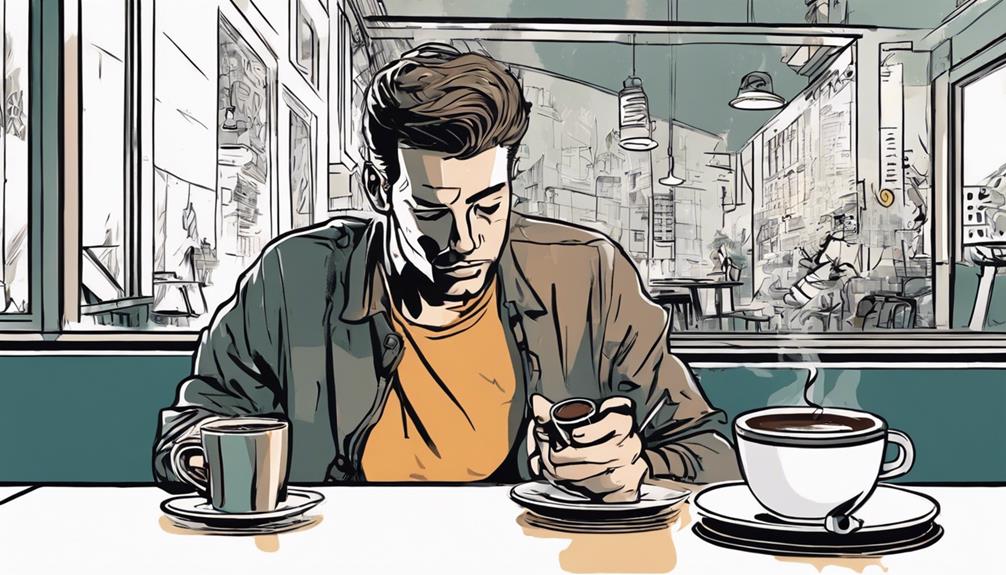To prevent coffee acidity, try opting for low-acid beans such as Sumatra, Brazil, or Guatemala. Dark roasts are better than light ones, and consider shade-grown coffee for a gentler taste. Cold brews are generally less acidic. Experiment with different brewing methods like coarser grinds or cooler water. If you want to enjoy coffee without stomach upset, try exploring new coffee varieties and various roasts for unique flavors. Milk-based drinks can also help neutralize acidity. By varying your choice of beans and brewing methods, you can balance flavors and acidity levels, resulting in a smoother experience for your stomach.
Key Takeaways
- Opt for dark roasts to reduce acidity in coffee.
- Choose beans from low-acid regions like Sumatra or Brazil.
- Consider cold brew for a smoother, less acidic option.
- Experiment with milk-based drinks to neutralize acidity.
- Use brewing methods like coarser grinds for lower acidity.
Choosing Low-Acid Coffee
To choose low-acid coffee, consider opting for beans from regions like Sumatra, Brazil, Guatemala, Peru, Nicaragua, or Mexico known for their reduced acidity levels. These coffee beans are renowned for providing a smoother, less acidic flavor profile, making them a gentler option for your stomach.
When brewing a cup of low-acid coffee, you can further tailor the acidity levels to your preference. Dark roasts are generally less acidic than light roasts, making them an excellent choice for those with sensitive stomachs. Additionally, selecting shade-grown coffee can also contribute to a milder coffee experience due to its reduced acidity.
If you want to experiment further, try adjusting your brewing methods by using coarser grinds, fine filters, or lower water temperatures to make your cup of coffee even less acidic. By considering these factors, you can enjoy a delicious and stomach-friendly brew without compromising on flavor.
Factors Affecting Coffee Acidity

When it comes to the acidity of your coffee, several factors play a role. Arabica beans tend to have higher acidity levels due to their citric acid content.
While the roasting process can impact acidity, with lighter roasts retaining more acidity than darker ones.
Additionally, the brewing method you choose can also affect the overall acidity of your cup of coffee.
Acidic Coffee Sources
The acidity levels in coffee are influenced by various factors, such as the type of beans used and the roasting process. Arabica beans are considered more acidic due to their higher citric acid content, while Robusta beans offer a bolder taste with lower acidity levels.
Lighter roasts tend to preserve more acidity compared to darker roasts, making them potentially harsher on the stomach. Experimenting with brewing methods like cold brew coffee can also impact the overall acidity of your cup.
Opting for low acid coffee varieties or gentler brewing methods may help reduce the acidity levels, making it easier on your digestive system. When selecting your coffee beans, consider the type of beans and the roasting process to find a blend that suits your taste preferences and stomach sensitivity.
Acidity and Roasting
During the roasting process, the acidity levels of coffee beans are influenced by various factors, including the type of beans used and the duration of roasting.
Lighter roasts, with their shorter roasting times, tend to retain more acidity compared to Dark Roasts.
Arabica beans, known for their higher acidity levels due to increased citric acid content, contribute significantly to the overall acidity of the coffee.
The roasting process is pivotal in determining the acidity levels, as different roasting durations can either enhance or reduce the acidity in the beans.
These variations in acidity levels play a vital role in shaping the flavor profile of the coffee, providing diverse taste experiences for coffee enthusiasts.
Brewing Impact on Acidity
To achieve a balanced acidity in your coffee, consider exploring different brewing methods that can influence the overall flavor profile of your brew. Brewing methods, such as cold brewing, play a pivotal role in determining the acidity levels of your cup of coffee. Cold brewing, for instance, tends to produce a smoother and less acidic cup compared to traditional hot brewing methods.
The origin and type of beans used in your coffee also greatly impact the acidity levels. Factors like elevation, drying methods, and bean type all contribute to the varying acidity levels in your brew. Lighter roasts, which undergo shorter roasting times, retain more acidity compared to darker roasts. The roasting process itself is essential in determining the acidity levels of your coffee, with lighter roasts generally being more acidic.
Experimenting with different brewing methods and understanding how factors like the origin of beans and roasting process influence acidity levels can help you tailor your coffee to achieve the desired balance of flavors.
Health Impacts of Acidic Coffee

Regularly consuming acidic coffee can lead to discomfort, acid reflux, and stomach irritation. This acidity might contribute to heartburn and gastritis over time, while also posing risks to your tooth enamel and oral health.
Opting for less acidic coffee varieties can help alleviate these issues and provide a more enjoyable coffee experience.
Acidic Coffee Health Risks
Consuming acidic coffee regularly can lead to various health risks, including discomfort, acid reflux, and stomach irritation.
The high acidity levels in coffee can trigger acid reflux, causing a burning sensation in your chest and throat. This acidity can also contribute to stomach irritation, potentially leading to conditions like gastritis.
Additionally, the acid in coffee can erode tooth enamel over time, negatively impacting oral health.
To mitigate these risks, consider switching to low-acid coffee options. Choosing less acidic coffee varieties can be gentler on your stomach and may help reduce the likelihood of experiencing digestive issues associated with high acidity.
Stomach Discomfort Effects
Acidic coffee can have harmful effects on your stomach, leading to discomfort, acid reflux, and potential irritation. The high acidity in coffee can trigger conditions like gastritis and heartburn, causing stomach discomfort and digestive issues.
Additionally, the acidity in coffee can harm tooth enamel over time, contributing to dental problems. To counteract these stomach discomfort effects, opting for coffee with reduced acidity levels can be advantageous. Choosing milder, low-acid coffee options can help alleviate these issues, making it gentler on your stomach and reducing the risk of acid-related problems.
Oral Health Concerns
High acidity in coffee poses risks to your oral health by potentially harming tooth enamel, leading to dental issues. Understanding the impact of acidic coffee on your oral health is crucial, especially regarding enamel erosion and tooth sensitivity. Opting for less acidic or low-acid coffee options can help reduce these risks, promoting improved oral health in the long term. Selecting smoother, stomach-friendly varieties can significantly lower the chances of developing dental problems linked to acidic coffee consumption.
To help you grasp the significance of choosing the correct coffee for your oral health, here's a comparison table:
| Aspect | Acidic Coffee | Less Acidic Coffee | Low-Acid Coffee Options |
|---|---|---|---|
| Impact on tooth enamel | Can harm enamel | Gentler on enamel | Helps minimize erosion |
| Dental issues risk | Higher risk | Lower risk | Better for oral health |
| Tooth sensitivity | May contribute | Less likely | Reduces sensitivity |
Benefits of Less Acidic Coffee

Choosing coffee with lower acidity levels can result in various benefits for your digestive system and overall well-being.
Less acidic coffee is stomach-friendly, serving as an excellent option for individuals prone to heartburn and stomach irritation.
By opting for low-acid coffee, you can reduce acidity in your system, potentially alleviating digestive issues and discomfort.
Additionally, low-acid coffee acts as an acid reducer, promoting a gentler experience on your stomach and oral health.
Enjoying less acidic coffee not only helps in maintaining enamel health and preventing dental problems but also enhances the overall flavor and experience for coffee enthusiasts.
Making the switch to low-acid coffee brands can significantly contribute to your health benefits, providing a more enjoyable and soothing coffee-drinking experience while caring for your digestive system and oral well-being.
Exploring New Coffee Varieties

To expand your coffee experience and potentially discover stomach-friendly options, consider exploring new coffee varieties that offer unique benefits and flavors. While limited research exists on how these new coffee types affect digestive symptoms, experimenting with different varieties like double-fermented and green coffee beans may help identify options that are gentler on your stomach. Personal responses to various coffee varieties vary, highlighting the importance of individual experimentation to find what works best for you.
When exploring new coffee varieties, you might want to try different roast levels such as dark roasts, which can offer a bolder flavor profile that might be less acidic. Additionally, consider trying cold brew coffee, which tends to be smoother and less acidic than a hot cup of coffee. For those looking to reduce acidity in their coffee, opting for milk-based drinks can help neutralize the acidity and make your coffee more stomach-friendly. Remember, the taste preferences and health benefits associated with each variety can greatly impact your overall coffee experience.
Caffeine and Digestive Health

Caffeine's impact on digestive health varies depending on individual tolerance levels and the type of coffee consumed. Caffeine can stimulate stomach acid production and digestive contractions, potentially affecting stomach health.
Different coffee varieties exhibit varying acidity levels, with hot-brewed coffee generally higher in acid than cold-brewed options. Surprisingly, dark roast coffee has been found to produce less stomach acid compared to medium roast, which could be beneficial for individuals with sensitive stomachs.
When it comes to mitigating the surge in stomach acid caused by caffeine, adding milk to coffee is a common practice. Milk can bind to chlorogenic acids in coffee, potentially reducing its impact on acid levels.
It's essential to recognize that personal caffeine tolerance plays a significant role in how coffee affects digestive health. Understanding these nuances can help individuals make informed choices to enjoy their coffee without compromising their stomach's well-being.
Frequently Asked Questions
How Do You Make Coffee Less Acidic for Your Stomach?
To make coffee less acidic for your stomach, opt for low-acid beans from regions like Sumatra or Guatemala, try dark roasts, use paper filters for smoother taste, add milk, or cream, and consider cold brewing with filtered water.
How to Drink Coffee Without Getting Acid Reflux?
To drink coffee without getting acid reflux, choose low acid beans from regions like Sumatra or Brazil. Opt for darker roasts, try cold brewing, or add milk to neutralize acidity. Consider low acid decaf as an alternative.
How Do You Stop Coffee From Irritating Your Stomach?
To stop coffee from irritating your stomach, opt for low-acid beans from Brazil, Sumatra, or Peru. Try cold brewing with coarse grounds and filtered water. Add milk to neutralize acidity. Use paper filters. Choose dark roast beans for a bolder taste with lower acidity.
What Foods Prevent Acidity in Coffee?
To prevent acidity in coffee, try adding oat milk, banana slices, honey, cocoa powder, or ginger. These ingredients can help neutralize acidity and make your coffee gentler on your stomach. Enjoy a soothing cup! If you are experiencing frequent acidity after drinking coffee, you may want to consider reducing your overall coffee consumption or opting for low-acid coffee beans. Additionally, if you are pregnant, it is advisable to consult with your doctor about avoiding coffee during pregnancy due to its potential impact on acidity and other digestive issues. Remember to listen to your body and make choices that are best for your health.
Conclusion
As you sip on a cup of low-acid coffee, imagine the soothing waves of a calm ocean washing away any potential acidity from your stomach. Picture yourself breathing in the crisp, salty air of the coast as you take another sip. The gentle rhythm of the waves can also have a calming effect on your body, reducing heart rate and promoting a sense of relaxation. With each sip, feel the acidity levels in your body decrease, leaving you feeling refreshed and rejuvenated.
By choosing coffee with lower acidity levels and being mindful of how it affects your digestive health, you can enjoy your favorite beverage without any discomfort.
Remember, a gentler brew can lead to a happier tummy and a more enjoyable coffee experience overall.
Cheers to good health and happy sipping!









